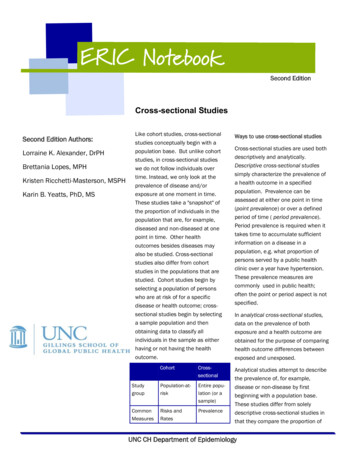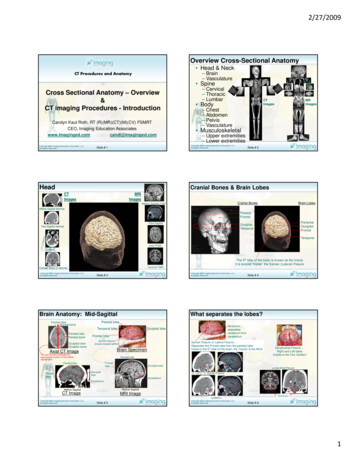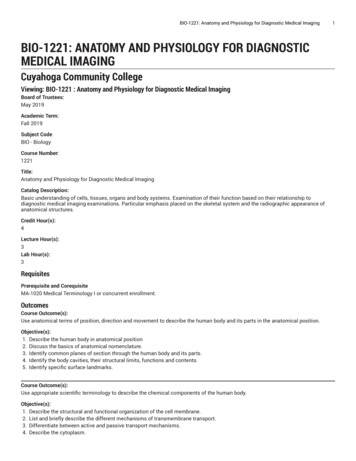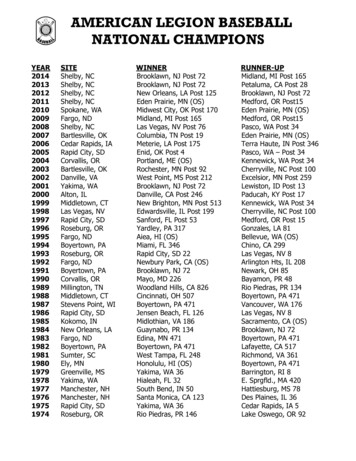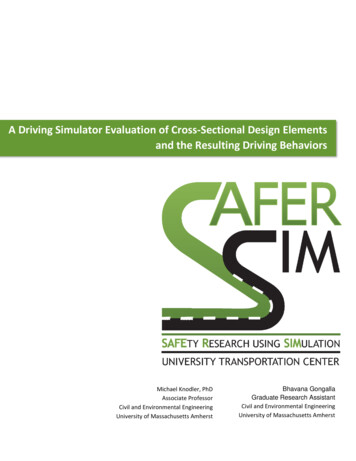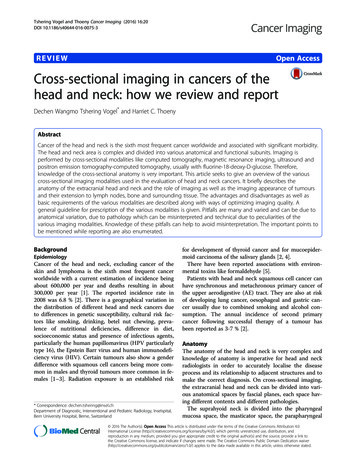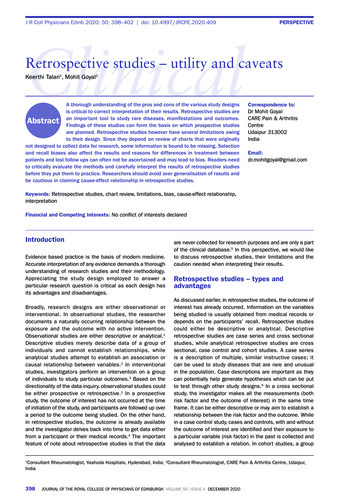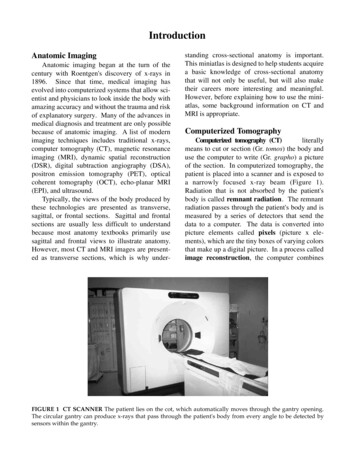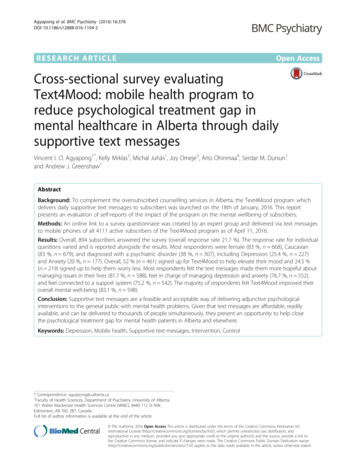
Transcription
Agyapong et al. BMC Psychiatry (2016) 16:378DOI 10.1186/s12888-016-1104-2RESEARCH ARTICLEOpen AccessCross-sectional survey evaluatingText4Mood: mobile health program toreduce psychological treatment gap inmental healthcare in Alberta through dailysupportive text messagesVincent I. O. Agyapong1*, Kelly Mrklas2, Michal Juhás1, Joy Omeje3, Arto Ohinmaa4, Serdar M. Dursun1and Andrew J. Greenshaw1AbstractBackground: To complement the oversubscribed counselling services in Alberta, the Text4Mood program whichdelivers daily supportive text messages to subscribers was launched on the 18th of January, 2016. This reportpresents an evaluation of self-reports of the impact of the program on the mental wellbeing of subscribers.Methods: An online link to a survey questionnaire was created by an expert group and delivered via text messagesto mobile phones of all 4111 active subscribers of the Text4Mood program as of April 11, 2016.Results: Overall, 894 subscribers answered the survey (overall response rate 21.7 %). The response rate for individualquestions varied and is reported alongside the results. Most respondents were female (83 %, n 668), Caucasian(83 %, n 679), and diagnosed with a psychiatric disorder (38 %, n 307), including Depression (25.4 %, n 227)and Anxiety (20 %, n 177). Overall, 52 % (n 461) signed up for Text4Mood to help elevate their mood and 24.5 %(n 219) signed up to help them worry less. Most respondents felt the text messages made them more hopeful aboutmanaging issues in their lives (81.7 %, n 588), feel in charge of managing depression and anxiety (76.7 %, n 552),and feel connected to a support system (75.2 %, n 542). The majority of respondents felt Text4Mood improved theiroverall mental well-being (83.1 %, n 598).Conclusion: Supportive text messages are a feasible and acceptable way of delivering adjunctive psychologicalinterventions to the general public with mental health problems. Given that text messages are affordable, readilyavailable, and can be delivered to thousands of people simultaneously, they present an opportunity to help closethe psychological treatment gap for mental health patients in Alberta and elsewhere.Keywords: Depression, Mobile health, Supportive text messages, Intervention, Control* Correspondence: agyapong@ualberta.ca1Faculty of Health Sciences, Department of Psychiatry, University of Alberta,1E1 Walter Mackenzie Health Sciences Centre (WMC), 8440 112 St NW,Edmonton, AB T6G 2B7, CanadaFull list of author information is available at the end of the article The Author(s). 2016 Open Access This article is distributed under the terms of the Creative Commons Attribution 4.0International License (http://creativecommons.org/licenses/by/4.0/), which permits unrestricted use, distribution, andreproduction in any medium, provided you give appropriate credit to the original author(s) and the source, provide a link tothe Creative Commons license, and indicate if changes were made. The Creative Commons Public Domain Dedication o/1.0/) applies to the data made available in this article, unless otherwise stated.
Agyapong et al. BMC Psychiatry (2016) 16:378BackgroundMental disorders can cause significant changes in behaviour, thought patterns, and mood of individuals in allages and socioeconomic backgrounds [1]. Mental illnessis a complex and pervasive burden to both individualsand our health system; its treatment is often challengingand resource intensive [2–4]. Mental health problemsvary greatly by their nature, ranging in presentation frominsular, episodic problems to longer term, chronic conditions requiring continuous, ongoing therapy. Mental illness is currently the most prevalent disability in Canada,generating 70 % of documented costs with a cumulativeannual economic impact of approximately 8B in directcosts (i.e. hospital and physician visits and medications),and between 11B and 50B in indirect costs [5]. Mentalillnesses are of primary health, social, and economic significance, given their common coexistence with othermental health and/or other chronic diseases [6, 7]. By2030, prevalence estimates identify depression to be theleading disability around the globe [8]. Identifying effective, cost-conservative treatments and management techniques for mental illness, especially depression, is apriority for health care systems worldwide.Depressive and bipolar disorders are the most prominent mental health problems in Canada, with an estimatedprevalence of 4.7 and 1.5 %, respectively, with 11.3 and2.6 % of adults reporting symptoms of major depressiveand bipolar disorders at some point in their lives [9].Women are diagnosed with depressive disorders at approximately double the rate of their male counterparts[10] and are more likely to seek medical attention for thiscondition. As with many mental health illnesses, depression is a diverse condition, with an equally diverse set oftreatment options including pharmacotherapy, psychosocial interventions, counselling, and outreach services[11]. These services usually require referral and are offeredonly in brick-and-mortar health centres with highlytrained health care professionals who can only serve a limited number of clients per day using the traditional therapeutic intervention methods.The recent Alberta provincial gap analysis revealedthat approximately 20 % of adults experienced addictionor mental health problems. Of the surveyed adults, 49 %either needed but did not receive or did not receive adequate services to address their mental health needs.The gap analysis also identified a lack of sufficient accessto counselling in 42 % of depressed Albertans. In fact,less than 25 % of depressed Albertans reported theirmental health service needs were fully addressed. Thesefindings are consistent with program-level survey reportsindicating that mental health service needs exceed available resources [7].The 2014 gap analysis also revealed significant geographic variations in the distribution of disease burdenPage 2 of 12for addictions or mental health problems, with northern communities experiencing on average the highestprevalence of mental health problems in Alberta.Rural Albertans are disadvantaged with respect tomental health and addictions services access. Giventhat the most commonly reported treatment modalityfor addictions or mental health problems is individualtherapy and counselling, it is unsurprising that unmetcounselling needs are common.The issue of disparate service access and disproportionate mental health and addictions disease burden innorthern populations is further exacerbated by currentunderutilization of existing mobile and electronic technology to reach clients. Gap analysis findings revealedthat only a minority of programs provided screening, assessment, treatment, peer support and follow-up care byphone (between 19 to 40 % depending on the service),and use of the internet is almost negligible for mentalhealth and addictions service delivery (between 2 and7 % of surveyed service providers) [7].Mobile health technology offers a convenient, cost conservative, and widely accessible modality for implementingpopulation-level interventions. In particular, the use oftext messaging either alone or in conjunction with otherinterventions has expanded greatly over the past five yearsin health care [12], and especially in mental health care[13]. A recent global survey revealed a significant increaseover the last two years in the proportion of individuals’median reported use of internet (87 %) and ownership ofsmart phones (68 %). Among Western countries, Canadais in a high-use group, with 90 % of Canadians reportinguse of the internet and 67 % owning a smartphone [14]and within Canada, Albertans were the highest users ofwireless phone technology (over 90 % of households) [15].Within this context, text messaging offers an innovative,cost-effective strategy to enhance mental health servicesaccessibility and improve the efficiency of the overall service delivery [16]. Comparatively, text messaging offerssignificant advantages over similar technologies (e.g., emailor messaging apps) beyond its cost and efficiency. Textmessaging is available on most cell phones, and does notrequire software or mobile application downloads, external equipment, fixed lines, or other hardware to function.Text messages are secure (e.g., can be password protectedand stored until accessed by the end user), and the communication process relies on increasingly ubiquitous cellphone infrastructure, accessible even in the most remoteregions. As noted by Lim and colleagues, text messagingis a ‘respectful and useful mode of sending a message’ thatlacks the marketing and spamming challenges associatedwith other similar technologies [17, 18].Despite of high accessibility of mobile technologies [12],their application in the area of mental health and addictions service delivery is relatively limited [7]. However, text
Agyapong et al. BMC Psychiatry (2016) 16:378messages have been used in multiple areas of mentalhealth including addictions (31 %), schizophrenia (22 %),and affective disorders (17 %), with the majority of interventions employed as supportive messages (42 %) and forself-monitoring (42 %) [13]. Emerging findings documenta positive patient attitude towards text messaging as wellas improved treatment adherence, symptom surveillance, appointment attendance, and patient satisfactionwith management and health care service provisions[13, 19–25]. Text messaging use has also been welldemonstrated in a number of public health interventions[13, 19]. Nonetheless, there are recurring calls for comprehensive evaluative studies quantifying specific benefits,challenges, intervention effects, and cost effectiveness. Asnoted by Hall and colleagues (2015), there are key featuresof both the technology and the intervention itself that require further investigation, including the role of frequencyand timing of messages, the duration and interactivitylevel of text message interventions, the relative influenceof adjunct interventions and communication modalities,and the influence of design-level use of behaviour changetheory on the overall intervention effects [12].TheText4Mood program evaluation was designed toprovide guidance for the further development and refinement of a program to support text-based intervention inthe area of mental health and addictions services inAlberta. Patients in Northern Alberta can self-subscribe tothe Text4Mood program to receive daily supportive textmessages for six months by simply texting the word‘mood’ to 7606703130. The messages were written bycognitive behaviour therapists and counselors in partnership with mental health patients and are preprogrammed into an online software which deliversthe messages at 10.00 h each day. Text messages havebeen formulated based on cognitive behaviour therapy(CBT) principles to predominantly target mood andanxiety symptom improvement. A different message issent each day with no repetition of messages throughout the 180-day subscription period. The same message is delivered to all subscribers according to theday they joined the program, with no tailoring ofmessages to meet individual patient needs.Examples of the text messages included the following: If you keep on going, maintaining your hope andbelief that something good will happen, it generallydoes. One day at a time. There are two days in the week we should notworry about, yesterday and tomorrow. That leavestoday, live for today. What you do today, will determine how you aretomorrow. Rise up and take advantage of whateveropportunities today present and success will beyours tomorrow.Page 3 of 12 Today, I will focus on what I have instead ofwhat I have not. Within me lies to power tosucceed. I will work with what I have to reachmy goals. Compete only with yourself, measure yourprogress by looking backward. Your own hopesand aspirations are the only limits to how far youcan achieve.The Text4Mood program was launched on the 18th ofJanuary 2016 by the Alberta Health Services and had4111 subscribers by the 12th of April 2016.Given this background, the aim of this study was toevaluate the demographic and clinical profile of subscribers, the impact of a supportive text messaging program on the subscribers’ self-reported mental wellbeingand the attitudes of subscribers towards the mobilemental health intervention.MethodsStudy setting and subscribersPublic basic health care is provided universally to allresidents of Alberta (4,227,881 [26]) without directpoint-of-service payments through a provincial healthinsurance program administered by the Alberta HealthServices. The province is divided into five administrativehealth care zones: Calgary zone, Edmonton zone, Northzone, South zone and Central zone. The Text4Moodprogram was designed specifically to target residents ofthe North zone, although residents of other zones werenot precluded from signing up for the program. TheNorth zone has the largest geographic area of all Healthzones, with a population catchment of 501,367 in 2014[26]. There are two medium sized cities in the Northzone, Fort McMurray and Grande Prairie. Both citieshave regional hospitals that also serve the physical andmental health needs of smaller outlying towns and cities,some of which are hundreds of kilometres away. Thevast majority of the region is rural-remote, with smallerprimary healthcare facilities in towns and cities. Giventhe geographic spread, residents in these towns usuallytravel long distances to either Fort McMurray or GrandePrairie for secondary and specialised healthcare services(including Cognitive Behaviour Therapy), which oftenimpairs the practical accessibility of these services. TheText4Mood program was therefore designed and advertised primarily to patients seeking psychological orcounselling services for depression and anxiety atprimarily and secondary care centres across NorthernAlberta, in order to help narrow the psychologicaltreatment gap for patients experiencing these mentalhealth difficulties. However, as patients self-subscribeto the program, there is no mechanism to prevent patients with other mental health conditions or even the
Agyapong et al. BMC Psychiatry (2016) 16:378general public from subscribing to the service. All survey data, including diagnostic information was selfreported by subscribers and not validated using clinicalassessment tools (e.g., rating scales or structured clinical interviews).Developing and administering the survey toolThe survey questions were formulated based on the objectives of the study and available evidence from peerreviewed literature. The survey consisted of predominatelyLikert scale responses and a few open-ended short answerquestions evaluating the following:Page 4 of 12the Text4Mood program on participants’ mentalwellbeingSubscriber satisfaction and interest in technologically basedhealth services How satisfied were respondents with the frequencyof the supportive text messages? Ideally, how frequently will respondents like toreceive the supportive text messages? Will participants welcome other technologicallydelivered healthcare solutions as part of theiroverall health care packages?Sociodemographic characteristics(i) Sex, (ii) Age, (iii) Ethnic background, (iv) Educationalbackground, and (v) Employment status.Clinical characteristics Whether respondents have been diagnosed with amental health condition or not. If diagnosed with a mental condition, what was thecondition? Whether respondents have been diagnosed with aphysical health condition or not. If diagnosed with a physical health condition,what was the condition?How and why respondents subscribed to theText4Mood program Where did the respondents hear about theText4Mood program? Why did the respondents sign up for theText4Mood program? Did respondents need any assistance in signingup for the program?Subscribers’ response to and perceptions about thesupportive text messagesDraft survey questions were programmed into SurveySelect, an online survey tool owned and operated by theAlberta Health Services Evaluation Services Team. Theonline survey was pre-tested with ten respondents (fourof whom were clinically depressed) who were not enrolled in the Text4Mood program. The survey questionswere revised based on pre-test findings. AdditionalLikert scale responses were drafted from several of theopen-ended questions. A second survey pretest wasundertaken on five additional respondents (two of whomwere clinically depressed) and took participants approximately 5 min to complete. Incentives were not offered torespondents for taking part in the survey pretests, nor aspart of the survey evaluation itself. Participation in all ofthe questionnaires was entirely voluntary.The online survey link was distributed to all subscribers of the Text4Mood program on their 42nd day(six weeks) of the program. The link was sent to subscribers between the 1st of March 2016 and the 11th ofApril 2016 to allow all subscribers reaching day 42 ofthe program to complete the survey. On the final day ofthe program, a reminder text message with the surveylink was sent to all 4111 subscribers of the Text4Moodprogram, including those who had not yet reached sixweeks on the program, encouraging them to completethe survey. The survey was left open for 24 h after thatand closed on the 12th of April 2016. How frequently did the respondents read the dailysupportive text messages? How did the respondents respond to the supportivetext messages? Did the respondents perceive the supportive textmessages to be on-topic, to the point, supportive,and positive?Impact of the Text4Mood program of subscribers’ mentalwell being Agreement or disagreement with variousstatements reflecting personal positive benefits ofData analysisAll data from the survey tool was recorded in a spreadsheet. Quantitative data was analysed using descriptivestatistics. Results were reported as either numbers andpercentages or bar graphs. Qualitative data was analysedthematically and representative verbatim quotes provided as appropriate to support the quantitative results.ResultsOf 4111 active subscribers to the Text4Mood program,894 completed the survey, amounting to an overall response rate of 21.7 %. The demographic and clinical
Agyapong et al. BMC Psychiatry (2016) 16:378characteristics of the respondents are summarised inTable 1. The ‘n’ for each individual characteristics variedand is reported alongside the results.The majority of respondents were of female sex (83 %,n 668) and Caucasian ethnicity (83 %, n 679). Half ofthe respondents were 26–45 years old (51 %, n 410),while almost one-third were 45–65 years old (31 %,n 253). Many respondents identified university degree or diploma (Bachelor’s) as their highest level ofeducation (32 %, n 260), followed by college diploma (23 %, n 189), high school (20 %, n 161),Post-Graduate Degree (12 %, n 98), and Apprenticeor Trade certificate (7 %, n 57). Overall, 38 % (n 307)of participants reported they have been officially diagnosed with a chronic mental health condition includingdepressive disorder (25.4 %, n 227) and anxiety disorder(20 %, n 177). The majority of respondents receivedmedical care from the Edmonton zone (42 %, n 375) andthe North zone (34 %, n 301).How respondents’ learnt about the Text4Mood programand reasons for subscribing to the programThe most common ways respondents heard about theText4Mood program were through a friend (22 %, n 198),on the news (19 %, n 168), other (18 %, n 161), on awebsite (14 %, n 125), on Facebook (11 %, n 98) andfrom a poster (9 %, n 80). The least common meansof hearing about the program were from a poster (6 %,n 60), from a clinic (3 %, n 30), the participant’s doctor or nurse (3 %, n 31), and Twitter (2 %, n 20).When respondents were asked why they signed up forthe Text4Mood program, some respondents selectedmultipole responses, with approximately half of respondents indicating they signed up for text for mood to helpelevate their mood (51.6 %, n 461) or to help them feelbetter (49 %, n 440). About a quarter indicated thatthey signed up for the program to help them worry less(24.5 %, n 219) whilst about a fifth said they signed upbecause of the novelty or fun of the program (19.7 %,n 176). Furthermore, 15.9 % of respondents indicatedthey signed up for the program for ‘other reasons’. Ofthose respondents who selected the ‘other’ category,the majority of the respondents signed up for this program to get support, motivation, inspiration/encouragement, to exercise positive thinking or to use theprogram as a reminder to practice mindfulness andview life from a positive perspective. In addition, a few respondents signed up to address specific concerns such as,“ground my anxiety,” help with “potential postpartum depression,” or “to help fight an addiction.” Other respondents signed up to be able to share positive thoughts or tosupport their families or friends who are dealing withmental health issues. A few respondents were curiousabout the service and wanted to try it. Finally, somePage 5 of 12respondents were mental health service managers or providers (such as psychologists) who signed up to test if theservice was appropriate to recommend to their clients ortheir clinical staff.“I work in mental health and wanted to see what theservice was like prior to recommending to my clients.”“To see if my patients would benefit from it”The majority of respondents did not need assistancesigning up for the program (96 %, n 694).Subscribers’ response to and perceptions of thesupportive text messagesWhen asked how often they read the text messages,the majority of respondents (90 %, n 648) said they‘always’ read the text messages. Only 8.1 % (n 58)read the text messages ‘often’ and 1.5 % read themessages ‘sometimes’.Overall, three-quarters of respondents (76 %, n 545)said that they ‘always’ understood the text messages thatthey received, 22.9 % said they ‘mostly’ understood thetext messages, and 1.4 % said they ‘sometimes’ understood the text messages. The actions respondents reportedly take in response to the daily text messages are: “I read and reflect on the messages”- (65 %, n 584) “I return to read the text messages for support morethan once”- (33 %, n 295) “I read the messages and take a positive action”-(29 %, n 258) “I read the text messages and take no action”-(18 %, n 160) “I read the messages and take a negative action”-(0.1 %, n 1) “I do not read the text messages”-(0.9 %, N 8)Using a Likert scale, participants were asked to indicate their perceptions about the contents of the supportive text messages as to whether they were on-topic, tothe point, supportive, and positive. The responses are assummarised in Fig. 1.Overall, respondents always found the Text4Moodmessages to be positive (69 %, n 501) and on-topic(45 %, n 325). Respondents identified messages as always supportive 62 % (n 448) of the time and always tothe point 48 % of the time (n 347).Impact of the Text4Mood program on subscribers’ mentalwell beingParticipants were asked to express agreement or disagreement with statements reflecting the positive benefits of the daily supportive text messages to them on a
Agyapong et al. BMC Psychiatry (2016) 16:378Page 6 of 12Table 1 Demographic and clinical characteristics of respondentsVariableN (%)GenderaAgebEthnic origincHighest EducationdMale142 (17.5 %)Female668 (82.5 %)North Zone301 (34 %) 1516 (2 %)Calgary Zone114 (12.8 %)16–25122 (15.1 %)Central Zone51 (5.7 %)26–45410 (50.7 %)South Zone19 (2.1 %)46–65253 (31.3 %)Outside Alberta33 (3.7 %) 657 (0.9 %)Caucasian679 (83.1 %)First Nations/Metis/Inuit42 (5.1 %)Asian32 (3.9 %)Black8 (1 %)Other40 (4.9 %)Prefer not to disclose16 (2 %)Post Graduate Degree(MSc, PhD)98 (12 %)University Degree or Diploma260 (32 %)College Diploma189 (23 %)Apprenticeship/Trade Certificate 57 (7 %)or DiplomaeEmployment statusTable 1 Demographic and clinical characteristics of respondents(Continued)High School Diploma161 (20 %)Junior High School24 (3 %)Elementary School0 (0 %)Prefer not to disclose16 (2 %)Employed Fulltime441 (49 %)Employed Part-time151 (17 %)Self-employed54 (6 %)Student89 (10 %)Homemaker45 (5 %)Unemployed with no income45 (5 %)Unemployed on Governmentsocial benefits28 (3 %)Retired15 (1.7 %)Prefer not to disclose19 (2.1 %)Mental health condition Depressive Disorderrespondents had beenAnxiety Disorderdiagnosed withe,fTrauma and stressor relateddisorder227 (24.5 %)117 (19.8 %)58 (6.5 %)Bipolar Disorder34 (3.8 %)Substance Related Disorder24 (2.7 %)Personality Disorder14 (1.6 %)Schizophrenia SpectrumDisorder9 (1 %)Other Disorders19 (2.1 %)None454 (56 %)Where respondentsreceive medical careeEdmonton Zone375 (42 %)Total N 810 bTotal N 808 cTotal N 817 dTotal N 814 eTotal N 893fParticipants were able to select more than one answer; sum percentages isgreater than 100 %apersonal level. The responses are as summarized inFigs. 2, 3 and 4.In each category, the majority of respondents werein agreement with each statement. Most respondentsfelt hopeful in managing issues in their lives (81.7 %,n 588), followed by feeling in charge of managing depression and anxiety (76.7 %, n 552) and then feelingconnected to a support system (75.2 %, n 542).Most respondents felt hopeful in managing issuesin their lives (82 %, n 587), followed by feeling ontrack with life or when everyday stressors come up(73 %, n 522).The majority of respondents felt the Text4Mood improved their overall mental well-being (83.1 %, n 598)and made them feel like they could bounce back if theymade a mistake (77 %, n 554).Furthermore, 75 % of respondents (n 545) said thatthe messages made them feel ‘supported’ whilst only6.5 % indicated that the messages ‘Made no difference’.Only 1.1 % indicated that the messages made them‘Annoyed’. The majority of the respondents who chose‘other’ (18 %, n 127) stated that receiving the daily textmessage made them feel good. They found the text messages set a positive tone for their morning, making themfeel “motivated,” “happy,” and “inspired.” Some mentioned that they share them with friends and families tospread the inspiration and thought.“ they are so positive and uplifting everyone shouldbe having access to this wonderful tool.”“When everything is going bad, that message brightensmy day. I look forward to it every day.”“They just help me to get or stay more positive whenI am struggling.”Some respondents highlighted that they had mixedfeelings about the text messages. They found some messages to be inspiring and supportive, while other messages were ineffective and frustrating. Some respondents
Agyapong et al. BMC Psychiatry (2016) 16:378Page 7 of 12Fig. 1 Respondent’s Perception of the Text Messages, n 720found that the text messages did not alter their moodor feelings in anyway. A few participants found messages that had a religious tone (e.g. talked about God)to be inappropriate. Others felt that the messagesreminded them of their personal challenges leavingthem discouraged.“I am grateful for them, and basically after reading it,I tucked it away in my notes. Sometimes they made aLOT of sense for that particular day/moment, but I donot really feel like they, in and of themselves saved me.They are like a treat each day, and some days I sharethem, some days they really hit home and other daysthey made me feel upset, anxious and guilty. But I DONOT want to stop getting them!!”“Some are good. Others don't seem to be appropriatefor what I thought the service is.”Subscriber satisfaction and interest in technologicallybased health servicesOverall, the majority of respondents were very satisfiedor satisfied with the frequency of text messages receivedFig. 2 Benefits of Text4Mood I, n 720(95 %, n 681). Four percent of respondents (n 32)said they were neither satisfied nor dissatisfied with thefrequency of the text messages, whilst only 1 % (n 8) ofrespondents were dissatisfied. On the other hand, whenasked what should be the ideal frequency with which theText4Mood program should send messages to subscribers, while the majority of respondents preferredto receive supportive text messages once per day(68 %, n 491), a considerable number preferred to receivethe supportive text messages twice daily (17 %, n 122).On the other hand, 12 % (n 86) preferred to receive themessages once every other day and 3 % (n 22) preferredto receive the supportive text messages once a week.Respondents were asked if they would welcome arange of technology based services as part of their overall health care packages. The responses are summarizedin Fig. 5.The majority of respondents were most certainly infavor of text support for follow-up care (52 %, n 376)and in favour of text messaging for managing medicalappointments (57 %, n 409). Use of technology-basedservices as part of healthcare was also identified asmost certain for Emails for managing medical
Agyapong et al. BMC Psychiatry (2016) 16:378Page 8 of 12Fig. 3 Benefits of Text4Mood II, n 720appointments (49 %, n 355) and web-based counselling (42 %, n 376) by plurality of the respondents.DiscussionOverall, both the proportions of females and differenttypes of mental health disorders self-reported by Text4Mood survey respondents were generally consistent withglobal and provincial mental health prevalence trends[7], and the high, positive subscriber perception of thetext messaging intervention was also consistent with arecent review of the use of text messaging in mentalhealth [13].This study generated unique findings with respect toself-reported rationale for subscribing to a supportivetext message service. While most studies report reasonsfor adults seeking mental health services associated withspecific diagnostic condit
mental health and addictions services access. Given that the most commonly reported treatment modality for addictions or mental health problems is individual therapy and counselling, it is unsurprising that unmet counselling needs are common. The issue of disparate service access and dispropor-tionate mental health and addictions disease burden in
